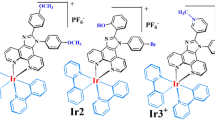Abstract
A new pyrene derivative substituted with isoniazid was synthesized via a simple Schiff base formation reaction, and its structure was characterized by using 1H-NMR, 13C-NMR, APT-NMR and elemental analysis techniques. Isoniazid-substituted pyrene (PINHy) was used as an emitting layer (EML) in the fabrication of new organic light-emitting diodes (OLEDs) consisted of bilayer or quaternary-layer system. We only used a hole transfer layer (HTL) and EML for the construction of the OLED device with bilayer system, while the OLED device with quaternary-layer system contained a combination of hole injection layer, HTL, EML and electron transfer layer. The optical and electrochemical properties of these materials were also examined. The results indicated that the OLED devices with quaternary-layer and bilayer system using isoniazid-substituted pyrene (PINHy) as EML showed efficient electroluminescent properties with the brightness of 906 and 864 cd/m2 at 11 V, the power efficiencies of 2.8 and 2.47 Im/W, and the external quantum efficiencies of 7.3 and 8.1% at 6.0 V, respectively.









Similar content being viewed by others
References
A.J. Stecki, J. Heikenfeld, S.C. Allen, Light wave coupled flat panel displays and solid-state lighting using hybrid inorganic/organic materials. J. Disp. Technol. 1, 157–166 (2005)
S. Akın, M. Gülen, S. Sayin, H. Azak, H.B. Yıldız, S. Sönmezoğlu, Modification of photoelectrode with thiol-functionalized Calix[4]arenes as interface energy barrier for high efficiency in dye-sensitized solar cells. J. Power Sources 307, 796–805 (2016)
Z. Shahedi, M.R. Jafari, A.A. Zolanvari, Synthesis of ZnQ2, CaQ2, and CdQ2 for application in OLED: optical, thermal, and electrical characterizations. J. Mater. Sci. (2017). doi:10.1007/s10854-017-6417-5.
J.-W. Park, Md..H. Ullah, S.S. Park, C.-S. Ha, Organic electroluminescent devices using quantum-size silver nanoparticles. J Mater Sci 18, 393–397 (2007)
D. Karthik, K.R.J. Thomas, J.-H. Jou, S. Kumar, Y.-L. Chen, Y.-C. Jou, Deep-Blue emitting pyrene-benzimidazole conjugates for solution processed organic light-emitting diodes. RSC Adv. 5, 8727–8738 (2015)
S.F. Varol, S. Sayin, S. Eymur, Z. Merdan, D. Ünal, Optical performance of efficient blue/near UV nitropyridine conjugated anthracene (NAMA) based light emitting diode. Org. Electron. 31, 25–30 (2016).
C.W. Kim, S.N. Park, S.B. Lee, J.J. Kim, H.W. Lee, Y.K. Kim, S.S. Yoon, Blue emitters based on aryl end-capped pyrene groups for OLEDs. J. Nanosci. Nanotechnol. 16, 2912–2915 (2016)
I.B. Berlman, Handbook on Fluorescence Spestra of Aromatic Molecules (Academic Press, New York, 1971)
W. Sotoyama, H. Sato, M. Kinoshita, T. Takahashi, A. Matsuura, J. Kodama, N. Sawatari, H. Inoue, Tetra-substituted pyrenes: new class of blue emitter for organic light-emitting diodes. SID Digest 34, 1294–1295 (2003)
Z.-Q. Wang, C.-L. Liu, C.-J. Zheng, W.-Z. Wang, C. Xu, M. Zhu, B.-M. Ji, F. Li, X.-H. Zhang, Efficient violet non-doped organic light-emitting device based on a pyrene derivative with novel molecular structure. Org. Electron. 23, 179–185 (2015)
M.T. Figueira-Duarte, K. Mullen, Pyrene-based materials for organic electronics. Chem. Rev. 111, 7260–7314 (2011)
F.M. Winnik, Photophysics of pre associated pyrenes in aqueous polymer solutions and in other organized media. Chem. Rev. 93, 587–614 (1993)
R. Zhang, Y. Zhao, T. Zhang, L. Xu, Z. Ni, A series of short axially symmetrically 1,3,6,8-tetra substituted pyrene based green and blue emitters with 4-tert-butylphenyl and arylamine attachments. Dyes Pigments 130, 106–115 (2016).
S.B. Lee, K.H. Park, C.W. Joo, J.-I. Lee, J. Lee, Highly twisted pyrene derivatives for non-doped blue OLEDs. Dyes Pigments 128, 19–25 (2016)
G. Zhang, X. Tian, L. Zhao, J. Wang, W. Jiang, X. Zhang, W. Dong, Y. Gao, Effects of DMPPP layer thickness on the performance of deep blue organic light emitting devices. J. Mater. Sci. 26, 1004–1008 (2015)
D. Chercka, S.-J. Yoo, M. Baumgarten, J.-J. Kim, K. Mullen, Pyrene based materials for exceptionally deep blue OLEDs. J. Mater. Chem. C 2, 9083–9086 (2014)
Y. Niko, S. Kawauchi, S. Otsu, K. Tokumaru, G. Konishi, Fluorescence enhancement of pyrene chromophores induced by alkyl groups through σ–π conjugation: systematic synthesis of primary, secondary, and tertiary alkylated pyrenes at the 1, 3, 6, and 8 positions and their photophysical properties. J. Org. Chem. 78, 3196–3207 (2013)
J.-F. Gu, G.-H. Xie, L. Zhang, S.-F. Chen, Z.-Q. Lin, Z.-S. Zhang, J.-F. Zhao, L.-H. Xie, C. Tang, Y. Zhao, S.-Y. Liu, W. Huang, Dumbbell-shaped spirocyclic aromatic hydrocarbon to control intermolecular π–π stacking interaction for high-performance non doped deep-blue organic light-emitting devices. J. Phys. Chem. Lett. 1, 2849–2853 (2010)
J.N. Moorthy, P. Natarajan, P. Venkatakrishnan, D.-F. Huang, T.J. Chow, Steric inhibition of π-stacking: 1,3,6,8-tetraarylpyrenes as efficient blue emitters in organic light emitting diodes (OLEDs). Org. Lett. 9, 5215–5218 (2007).
K.R. Justin Thomas, N. Kapoor, M.N.K. Prasad Bolisetty, J.-H. Jou, Y.-L. Chen, Y.-C. Jou, Pyrene-fluorene hybrids containing acetylene linkage as color-tunable emitting materials for organic light-emitting diodes. J. Org. Chem. 77, 3921–3932 (2012)
J.-Y. Hu, X.-L. Ni, X. Feng, M. Era, M.R.J. Elsegood, S.J. Teat, T. Yamato, Highly emissive hand-shaped π-conjugated alkynylpyrenes: synthesis, structures, and photophysical properties. Org. Biomol. Chem. 10, 2255–2262 (2012)
X. Feng, J.-Y. Hu, H. Tomiyasu, N. Seto, C. Redshaw, M.R.J. Elsegood, T. Yamato, Synthesis and photophysical properties of novel butterfly-shaped blue emitters based on pyrene. Org. Biomol. Chem. 11, 8366–8374 (2013)
J.K. Salunke, F.L. Wong, K. Feron, S. Manzhos, M.F. Lo, D. Shinde, A. Patil, C.S. Lee, V.A.L. Roy, P. Sonar, P.P. Wadgaonkar, Phenothiazine and carbazole substituted pyrene based electroluminescent organic semiconductors for OLED devices. J. Mater. Chem. C 4, 1009–1018 (2016)
S.F. Lim, W. Wang, S.J. Chua, Degradation of organic light-emitting devices due to formation and growth of dark spots. Mater. Sci. Eng. B 85, 154–159 (2001)
T. Ikeda, H. Murata, Y. Kinoshita, J. Shike, Y. Ikeda, M. Kitano, Enhanced stability of organic light-emitting devices fabricated under ultra-high vacuum condition. Chem. Phys. Lett. 426, 111–114 (2006)
Author information
Authors and Affiliations
Corresponding author
Rights and permissions
About this article
Cite this article
Sayin, S., Varol, S.F., Merdan, Z. et al. Synthesis of isoniazid substituted pyrene (PINHy), and investigation of its optical and electrochemical features as tunable/flexible OLEDs. J Mater Sci: Mater Electron 28, 13094–13100 (2017). https://doi.org/10.1007/s10854-017-7142-9
Received:
Accepted:
Published:
Issue Date:
DOI: https://doi.org/10.1007/s10854-017-7142-9




